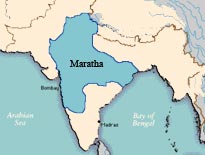The Maratha nation was founded by Shivaji after many battles and guerilla warfare against the Mughal Emperor Aurangzeb. Though he was successful, he died in 1680 leaving the kingdom vulnerable to attacks and external aggression. The state of Maratha was ruled by Shahu, a grandson of Shivaji till 1749. During his reign, Shahu appointed a Peshwa or a prime minister who would act as the head of the state under certain emergency conditions in the kingdom. With time, the Peshwas became the real rulers of the empire while the successors of Shivaji were just nominal heads of state. The Maratha Empire was successful at keeping the British forces from attacking India for most of the 18th century.
 The Marathas were essentially a Marathi speaking clan, hence the name
Marathas. The rise of the Marathas was the main reason for the decline
of the Mughal Empire. The rulers after Shivaji were able to withhold the
Maratha empire together thus making it one of the strongest empires in
India. Under the rule of Shivaji, the Maratha Empire saw its best days.
The area under the Marathas during the reign of Shivaji included the
Deccan, central India and some parts of present day Pakistan. After
Shivaji, the Maratha Empire suffered greatly at the hands of the Afghans
during the third battle of Panipat. Then came the British, who wanted to
include the Maratha Empire (which was reduced to a regional kingdom)
into the Bombay presidency.
The Marathas were essentially a Marathi speaking clan, hence the name
Marathas. The rise of the Marathas was the main reason for the decline
of the Mughal Empire. The rulers after Shivaji were able to withhold the
Maratha empire together thus making it one of the strongest empires in
India. Under the rule of Shivaji, the Maratha Empire saw its best days.
The area under the Marathas during the reign of Shivaji included the
Deccan, central India and some parts of present day Pakistan. After
Shivaji, the Maratha Empire suffered greatly at the hands of the Afghans
during the third battle of Panipat. Then came the British, who wanted to
include the Maratha Empire (which was reduced to a regional kingdom)
into the Bombay presidency. The Marathas were adamant about their territory and waged three fierce battles against the British. The result was that the British annexed the territory that was ruled by the Peshwas. Thus, ended a great empire that had ruled major parts of central and southern India with a firm hand.


